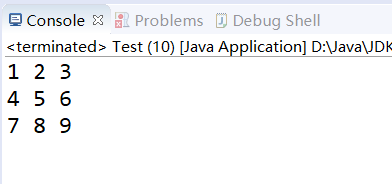目录
一、数组的创建和初始化
1、创建语法:

2、初始化:
①静态初始化
float[ ] scores = {1,2,3,4};
String[ ] str ={"How", "are","you"};②动态初始化
float[ ] scores = new float[ ]{21.4f, 56.9f};注意:定义int型数组后每个元素默认初始化0,boolean型默认为false。
二、for-each循环
1、含义:在访问数组中元素时,可使用for循环通过下标确定元素值,也可使用for-each循环优点是可避免下标访问异常。
2、语法:
package day11;
public class Test {
public static void main(String[] args) {
int[] num=new int[]{1,2,3};
System.out.println("使用for循环输出数组中元素:");
for(int i=0;i<num.length;i++) {
System.out.print(num[i]+" ");
}
System.out.println("
使用for-each循环输出数组中元素:");
for(int nums:num) {
System.out.print(nums+" ");
}
}
}
运行结果:

注意:
①上例中for-each循环括号中nums表示数组单个元素的类型。
②修改nums的值不会影响num数组中元素的值。
package day11;
import java.util.Arrays;
public class Test {
public static void main(String[] args) {
int[] num=new int[]{1,3,2};
System.out.println("修改前数组中的元素值:");
for(int i=0;i<num.length;i++) {
System.out.print(num[i]+" ");
}
System.out.println("
修改nums的值!");
for(int nums:num) {
nums++;
}
System.out.println("修改后数组中的元素值:");
for(int i=0;i<num.length;i++) {
System.out.print(num[i]+" ");
}
}
}
运行结果:

三、数组操作与Arrays类
1、数组排序
package day11;
import java.util.Arrays; //sort方法在Arrays类中
public class Test {
public static void main(String[] args) {
int[] num=new int[]{1,3,2};
Arrays.sort(num);
System.out.println("排序后的元素顺序为:");
for(int nums:num) { //for-each循环输出元素
System.out.print(nums+" ");
}
}
}
补充:Math.random()生成随机数
Math.random(); //随机生成[0~1)之间的浮点型 (int)(Math.random()*100); //随机生成[0~100)之间的整数
2、传数组类型的参数:
package day11;
public class Test {
public static void main(String[] args) {
int[] num=new int[]{1,3,2};
showInfo(num); //showInfo使用static修饰才可以直接使用方法名调用方法
}
public static void showInfo(int[] x) {
System.out.println("参数数组中的元素:");
for(int y:x) {
System.out.print(y+" ");
}
}
}
四、二维数组
1、理解:

注意:N*N的二维数组就可以想象成一个N*N矩阵,其中横纵坐标都是从0开始(这个必须得习惯)。
2、创建:
package day11;
public class Test {
public static void main(String[] args) {
int[][] num=new int[][]{{1,2,3},{4,5,6},{7,8,9}};
}
}
理解图:

3、二维数组的遍历:
package day11;
public class Test {
public static void main(String[] args) {
int[][] num=new int[][]{{1,2,3},{4,5,6},{7,8,9}};
for(int[] nums:num) {
for(int y:nums) {
System.out.print(y+" ");
}
System.out.println();
}
}
}
运行结果:

五、字符串String
1、创建:
package day11;
public class Test {
public static void main(String[] args) {
String str=new String("hello world");
}
}
2、常用方法
①获取长度:
str.length()②比较大小(字典序):
str.compareTo("nihao"); //大于返回正值,小于返回负值,等于返回0
str.compareToIgnoreCase("NIHAO");//不区分大小写比较③判断str1是不是str的子串:
str.concat(str1); //返回值为boolean类型④返回首次出现str1的位置下标:
str.indexOf(str1); //从头开始检索
str.indexOf(str1,index); //从index位置开始检索
str.lastIndexOf(str1);//从后向前开始检索
⑤拼接:
str.concat("!");//末尾处拼接⑥截取:
str.substring(start,end);//截取区间[start,end)3、'=='操作符
①基本类型值比较时,只要两个变量值相等即为true
②其余类型比较时,只有两个变量来自同一个对象时才为true
③使用==操作符判断时,两边的数据类型要兼容,否则编译错误
案例:判断返回值
int it = 65; float fl = 65.0f; System.out.println(“65和65.0f是否相等?” + (it == fl)); //true
4、equals方法
对类File、String、Date及包装类(Wrapper Class)来说,是比较类型及内容而不考虑引用的是否是同一个对象。
注意:equals方法仅能用于引用类型,因为equals方法是object中的方法。
补充(String对象的创建方式):
方式1:
String str1="hello world";
String str2="hello world";注意:该方式创建的两个字符串变量内存位置相同,所以若使用==判断,结果为true。
方式2:
String str1=new String("hello world");
String str2=new String("hello world");注意:使用该方法创建的字符串内存不同,使用==判断返回false。
5、String和其它数据类型转换
①字符串转换为其它数据类型:

②其它数据类型转换为字符串:

不足请留言评论,谢谢!